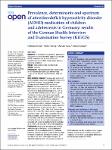Prevalence, determinants and spectrum of attention-deficit hyperactivity disorder (ADHD) medication of children and adolescents in Germany: results of the German Health Interview and Examination Survey (KiGGS)
Knopf, Hildtraud
Hölling, Heike
Huss, Michael
Schlack, Robert
Objective: To investigate the prevalence, determinants and spectrum of attention-deficit hyperactivity disorder (ADHD) medication and its associations with socioeconomic status (SES), health-related behaviour and living conditions. Design: Observational cross-sectional study. Setting: Germany. Participants: Representative population-based sample of non-institutionalised youth aged between 0 and 17 years (n=17 450) and examined between 2003 and 2006. Main outcome measure: Prevalence and spectrum of ADHD medication (Anatomical Therapeutic Chemical (ATC) code N04BA) measured by standardised computer-assisted personal interview (CAPI) on drug use. Results: The overall prevalence of ADHD medication (stimulants including atomoxetine) was 0.9% (95% CI 0.7% to 1.1%). Boys used these drugs (1.5%, 1.2% to 1.8%) five times more than girls 0.3% (0.2% to 0.5%). The highest prevalence rates were for boys aged 6–10 years (2.3%, 1.7% to 3.1%S) and 11–13 (2.7%, 2.0% to 3.7%). Boys from families with no immigration background used ADHD medication almost 6 times as frequently as boys with an immigration background (1.7% vs 0.3%). Multivariate analysis (binary logistic regression) showed boys (OR 5.16, 95% CI 3.15 to 8.47), 11-year-olds to 13-year-olds (2.24, 1.28 to 3.49), children in large cities (2.18, 1.13 to 4.22), children with no immigration background (3.06, 1.34 to 6.99), and children with only a good (vs excellent) parent-rated health status (1.91, 1.18 to 3.08) being more likely to be using ADHD medication. A visit to the doctor in the last month or last quarter was associated with a higher probability for ADHD medication (3.18, 1.29 to 7.95 and 3.59, 1.45 to 8.90, respectively). Conclusions: Results show prevalence rates of ADHD medication use for the German child and adolescent population that are considerably lower than published prevalence rates from the USA, but comparable with those of western European and Scandinavian countries. Lower use rates in rural versus urban regions may point to differential healthcare access. The inverse association of ADHD medication use with immigration status suggests potentially restricted access to healthcare services for immigrants or may reflect culture-specific differences in attitudes towards symptoms of ADHD.
No license information

